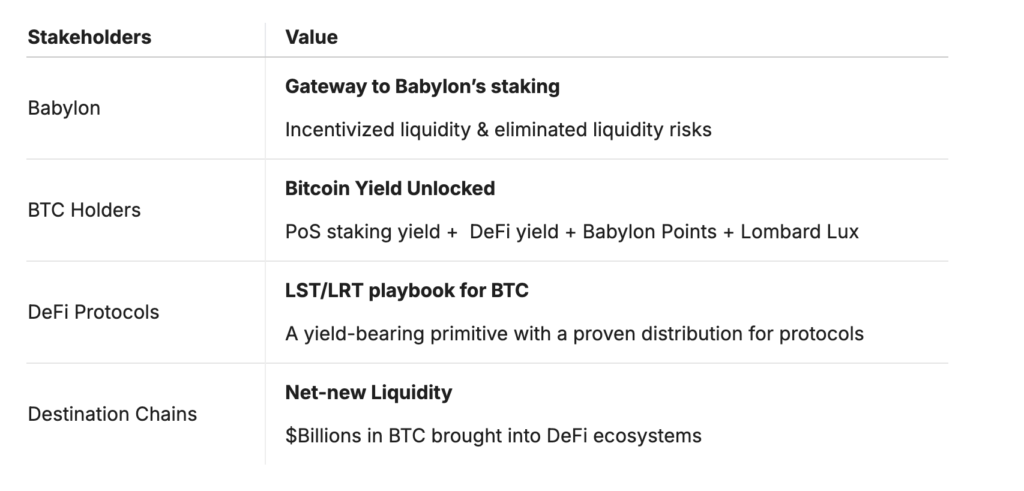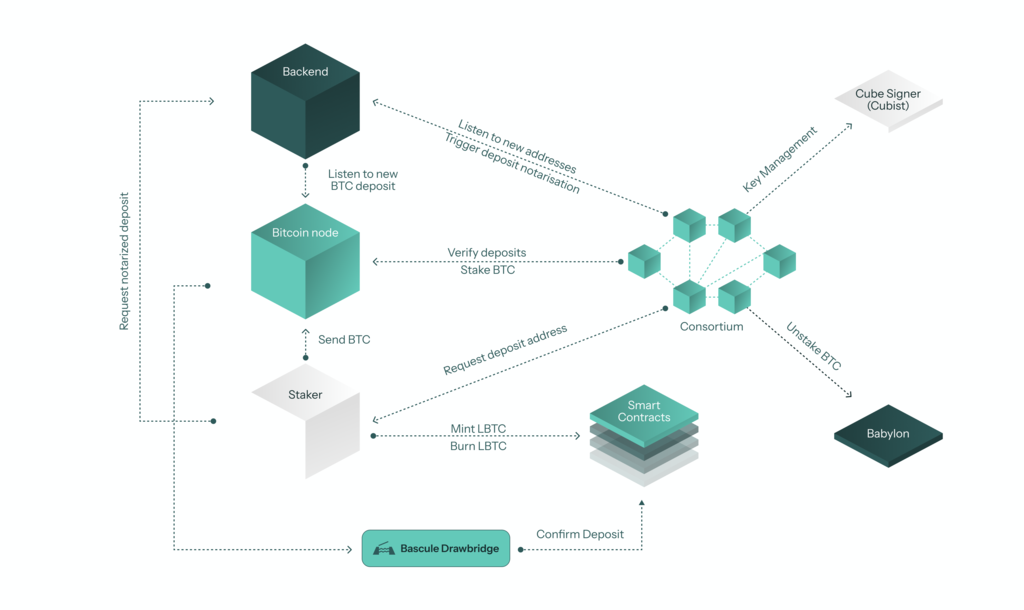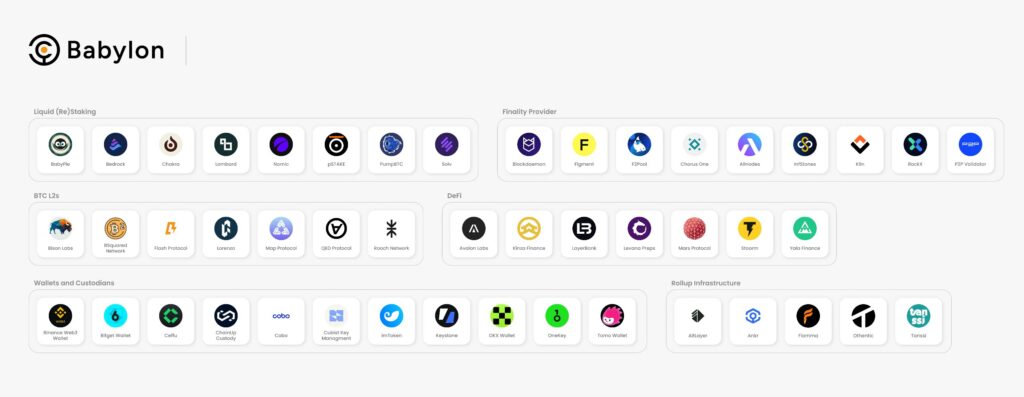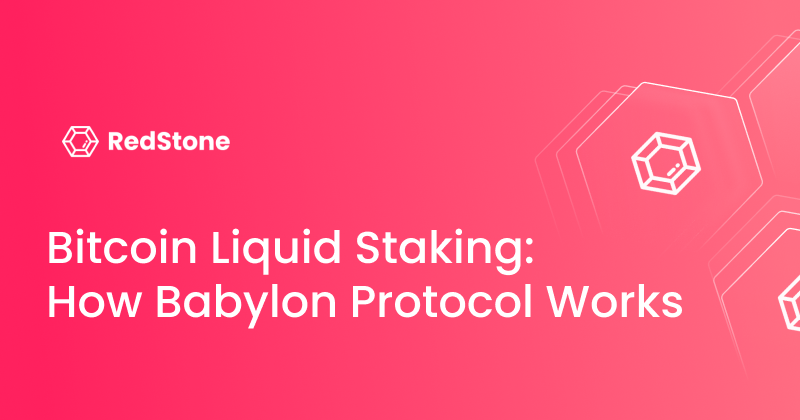This Article Covers:
– An explanation of how Babylon enables native Bitcoin staking for PoS chains.
– The consequences of Babylon staking for PoS chain security and Bitcoin holders.
– How Babylon enables Bitcoin liquid staking.
– An analysis of Bitcoin liquid staking (case study: Lombard Finance).
– The current state of Bitcoin liquid staking in 2024.
– The consequences of Bitcoin liquid staking derivatives on Bitcoin maximalism.
– The role of RedStone in supporting Bitcoin liquid staked price feeds.
Overview of BTC Liquid Staking
Until recently, Bitcoin holders who wanted to participate in staking and DeFi were typically required to purchase a wrapped version of Bitcoin, such as wBTC. Using a wrapped version of Bitcoin requires trusting an intermediary to issue the asset and ensure it is redeemable 1:1 for Bitcoin. While this innovation has been significant, it has trade-offs, including the inability to hold BTC natively on the Bitcoin network, which is the most secure way of holding Bitcoin. Recent developments in Bitcoin staking now allow BTC holders to secure proof-of-stake blockchains by staking their assets natively on the Bitcoin network. In other words, it is a way to participate in staking on the Bitcoin network exclusively.
Doesn’t Bitcoin Use Proof of Work?
Bitcoin remains the most decentralized blockchain, relying on proof-of-work (PoW) as its consensus mechanism. Adding new blocks to the Bitcoin blockchain requires participating in Bitcoin mining. This can be done by joining a mining pool or buying mining hardware and solving the PoW Hashcash puzzle directly. Therefore, Bitcoin holders cannot stake their assets to secure the network. Ethereum and many other blockchains rely on a different consensus mechanism, Proof-of-Stake (PoS). PoS requires validators’ funds to be provided as collateral if they attempt to validate incorrect transactions in order to maintain security and earn rewards. Ethereum’s validators typically receive a staking yield of around 2.5-3% as a reward for correctly securing the network. For a more thorough look at staking yields, RedStone recently released a Composite Ether Staking Rate (CESR), the first on-chain benchmark for Ethereum staking yields. ETH holders can participate in staking through liquid staking protocols like Lido Finance and staking-as-a-service providers like Figment. Many Bitcoin holders would like to hold their Bitcoin natively while allocating it to generating additional yield. To address this, Babylon was created. Babylon allows Bitcoin holders to allocate their Bitcoin as collateral to validate other proof-of-stake chains and services without third-party trust or bridging to other chains.
Babylon Staking Protocol: Unlocking Native Bitcoin Staking
Babylon is a shared security protocol that allows Bitcoin to be used as collateral for the PoS ecosystem. It aims to enable Bitcoin to secure PoS chains without requiring a non-native BTC asset held on a PoS chain. To date, through two deposit windows known as Cap-1 and Cap-2, nearly 24,000 BTC, amounting to a massive $1.5 billion, has been deposited into Babylon. This initial cap was time-limited and filled within minutes. It is anticipated that significantly more BTC will be provided as Babylon continues to develop and increases its deposit cap. Babylon can be thought of as the equivalent of Eigenlayer, but instead of ETH and ERC-20 rehypothecation, it allows for outsourcing the economic security of Bitcoin. As of May 2024, EigenLayer has reached a Total Value Locked (TVL) of $19 billion, demonstrating the potential of the Bitcoin staking market.
How Babylon Enables Bitcoin Staking
A series of implementations are required to achieve native Bitcoin staking. Bitcoin is first locked in a vault on the Bitcoin network, and a proof demonstrating the successful addition of funds is provided to the PoS chain to facilitate the liquidity process. As the vault is on Bitcoin, it is coded in Bitcoin’s scripting language. Two critical conditions exist for the vault, including a slashing condition if the PoS chain is incorrectly secured, and a time-lock condition, which must be satisfied for a user to remove their funds from their vault. The amount staked in a vault on Bitcoin is communicated to PoS chains by using a timestamp service offered by Babylon. Simply put, this timestamp embeds information as a cryptographic proof, which is then referenced by PoS chains. After the Bitcoin is staked, the Bitcoin holder can start participating in validating blocks on the PoS chain.
The validator uses Extractable One-Time Signatures (EOTS), a cryptographic signature, to validate blocks. These signatures ensure that if a validator misbehaves (e.g., by double-signing a block), their private key will be exposed. The exposure of the private key ensures that the Bitcoin locked in the vault can be slashed (burned) as a penalty for the misbehavior. Babylon relies on custom vaults and cryptographic techniques rather than smart contracts to manage slashing and staking. This makes the system more secure as it avoids introducing unnecessary complexity or attack surfaces. Babylon’s system prevents users from moving their locked Bitcoin during a slashing event by using a unique “finality gadget.” This gadget ties checkpoints from the Proof of Stake (PoS) chain to Bitcoin’s PoW blockchain, ensuring that once a block reaches finality, it becomes permanent. By requiring Bitcoin’s blockchain to confirm the final state of the PoS chain, the system adds extra security and prevents users from avoiding slashing penalties.
The Consequences of Babylon Liquid Staking Solution for PoS Security and BTC Holders
Staking is not intended to be a financial instrument to generate low-risk yields in DeFi. Instead, it is designed to incentivize participation in securing PoS networks. While staking rewards are necessary for network security, there are several downsides to excessive participation in staking. Some of these consequences include diminishing returns on security as costs increase for validators, excessive inflation of ETH to reward validators, and centralization risks. Bitcoin as a base layer for securing external networks could potentially increase demand for Bitcoin, as PoS projects might need to interact with Bitcoin for anchoring or other functionalities. This marks an interesting transition of relying on Bitcoin for consensus for its decentralized track record, more than relying on Bitcoin as a peer-to-peer payment system as it was designed.
For Bitcoin holders, a new opportunity to earn yield on their BTC through the Bitcoin network is an obvious benefit. While this is currently achieved through WBTC, Babylon’s approach offers an alternative that presents new risks which may be more tolerable for Bitcoin holders. Additionally, this creates an opportunity for institutions and banks that hold Bitcoin to earn yield, making Bitcoin a more attractive asset. It also represents progress in the interoperability of Bitcoin with other blockchains.
Babylon and Bitcoin Staking Derivatives
Bitcoin liquid staking can be compared to Lido’s stETH, a tokenized representation of staked Ethereum. Protocols that issue yield generating Bitcoin leverage Babylon to stake BTC and issue a liquid derivative. For example, protocols like Lombard Finance and PumpBTC are financial services that allow users to stake their BTC and receive the yield-bearing derivatives, LBTC and yBTC respectively thus enhancing Bitcoin yields. These derivatives can then be used in DeFi. To incentivize platform use, points are earned by initial users of the platform to help bootstrap the project.
Case Study for BTC Staking: Lombard Finance
Lombard Finance is a Bitcoin staking protocol built on top of Babylon allowing users to hold BTC earning yield instead of holding Bitcoin idle. LBTC is the liquid staked token issued by Lombard finance representing the staked BTC provided to the protocol. Lombard allows both institutions and individual investors to earn yield on BTC. Bitcoin represents over 50% of the total cryptocurrency market, valued at around ~1.5$ trillion demonstrating the potential growth of DeFi through Lombard Finance and Babylon.
An overview of the actors in Lombard Finance is displayed in the table below.

Lombard Finance Under The Hood

Lombard Finance enables the staking, issuance, and redemption of LBTC through several key components, including secure key management, decentralized security validation, and integration with Babylon protocol for finality assurance. Their CubeSigner system ensures that cryptographic keys are tamper-resistant and non-custodial, which is crucial since Bitcoin managed by Lombard is protected by these keys. To stake BTC, it is sent to a designated address created by Lombard’s decentralized security group, the Consortium. CubeSigner generates a secure Bitcoin key and address, with strict policies ensuring it is only used for authorized transactions. Once BTC is transferred, Lombard monitors the blockchain, and after five confirmations, the Consortium verifies the transaction, including the amount and destination.
Lombard collaborates with Babylon’s Finality Providers to guarantee transaction finality. The staked BTC is secured through a special unspent transaction output (UTXO) that is locked by a timelock and an Extractable One-Time Signature (EOTS), ensuring it remains in a self-custodial vault and can only be accessed under predefined conditions. After staking, the staker becomes eligible to receive LBTC, a Bitcoin liquid staking token, which is usable on other blockchains like Ethereum. The Consortium validates the staking data and mints LBTC tokens on the destination blockchain, using signed data that includes the staked BTC amount, target chain ID, and a signature from the Consortium’s threshold key. A dual-signature process involving both the Consortium and the Bascule Drawbridge (an independent state oracle) ensures security during the minting process.
To unstake BTC, users burn their LBTC tokens on the blockchain where LBTC is supported. The Consortium verifies the burn transaction, unstakes the corresponding BTC, and ensures all security policies are followed before authorizing the transaction. Once verified, BTC is returned to the user’s address. The Consortium is governed by a decentralized state machine using the Raft algorithm. The combination of CubeSigner’s hardware security, decentralized validation, and Babylon’s finality guarantees makes Lombard Finance a secure and transparent system for integrating Bitcoin into DeFi.
The Current State of Liquid Staked Bitcoin in 2024
It is apparent that a significant amount of Bitcoin is willingly allocated to bitcoin staking. Notably, Solv, one of the leaders in Bitcoin staking, already has roughly 22,000 BTC in reserves, translating to over 1.4 billion dollars in value locked. Additionally, The TVL of PumpBTC has reached over 180M USD. Other protocols like Bedrock have a whopping $140M TVL for their Bitcoin staking functionality. The growth of these protocols is also exemplified by the amount of liquid Bitcoin derivatives minted. For example, Lombard Finance has minted more than 8500 LBTC.

Today the main Bitcoin liquid staking protocols built on Babylon include:
Lombard
Lombard is committed to expanding the digital economy by transforming Bitcoin’s utility from a store of value into a productive financial tool. Individuals and large institutions can access LBTC to earn yields on idle Bitcoin or fully participate in DeFi ecosystems.
Solv
SolvBTC is a token representation of Bitcoin held in Solv’s Decentralized Bitcoin Reserves, designed to enable Bitcoin liquidity to flow seamlessly across various chains. It provides crucial liquidity infrastructure for the Bitcoin-powered finance (BTCFi) ecosystem. Deployed on more than five major networks, including the Bitcoin mainnet, Ethereum mainnet, and BNB Chain, SolvBTC serves as a key liquidity provider with nearly 22,000 BTC in reserves. This liquidity has attracted significant players in the DeFi space, such as the Bitcoin staking protocol Babylon, the Synthetic Dollar Stablecoin Protocol Ethena, and other projects.
PumpBTC
PumpBTC serves as a liquid staking solution for Babylon, aiming to integrate DeFi into the Bitcoin ecosystem. With an ecosystem-centric approach supported by seasoned DeFi experts and industry-leading partners, PumpBTC simplifies collaboration between users and Babylon. Users can stake into Babylon with a single action through PumpBTC, receiving liquidity tokens immediately without any waiting periods.
pSTAKE
pSTAKE Finance allows users to liquid stake BTC and earn rewards from Babylon’s Trustless BTC staking, providing security for other app chains while maintaining liquidity. Powered by institutional custody providers like Cobo, pSTAKE Finance offers expertly curated yield strategies, enabling individuals and institutions to maximize the potential of their BTC within the BTCFi ecosystem.
BabyPie
BabyPie offers BTC holders the opportunity to enhance their rewards and flexibility through liquid staking. By depositing BTC on BabyPie, users receive mBTC in return and can validate new systems via Babylon.
Bedrock
Bedrock is a multi-asset liquid restaking protocol backed by a non-custodial solution, developed in partnership with RockX. Bedrock provides products such as Liquid Restaking Tokens (LRT) for Wrapped BTC, ETH, and IOTX.
Chakra
Chakra Network is a modular settlement layer designed to unlock Bitcoin’s liquidity across diverse blockchain ecosystems. Offering a high-performance, parallelized settlement solution, Chakra facilitates efficient liquidity flow across Layer 2s, AppChains, and native BTC assets.
Nomic
Nomic has introduced stBTC, a liquid staked Bitcoin token built on Babylon’s staking protocol. stBTC enables users to stake nBTC (Bitcoin on Nomic) via Babylon, providing proof-of-stake security for other chains in exchange for altcoin yields. Users staking Bitcoin through Babylon on Nomic earn both NOM and nBTC staking rewards, redeemable for BTC—a unique feature of the Nomic system.
Bitcoin Liquid Staking and Bitcoin Maximalism
While Bitcoin was designed to be a peer-to-peer payment system, it has grown in popularity to be treated as a store of value or speculative asset for investors in the crypto space. One could argue that developments like Babylon and liquid Bitcoin tokens increases the risk of Bitcoin’s security by tying it to DeFi and other blockchains. Additionally, as Bitcoin is used to transact with, and is not intended to be an investment that is ‘yield generating’ it may encourage additional trading.
How RedStone Supports Lombard’s LBTC
The LBTC token is designed as an omni-chain token, meaning it can be minted and transferred across multiple EVM chains. Currently, LBTC minting is enabled on the Ethereum network, and the Lombard team is actively working to expand support for new chains. RedStone delivers LBTC/BTC fundamental price using both Pull and Push models. The price is calculated as a ratio between BTC controlled by the Lombard protocol and the total supply of LBTC tokens across all supported chains, impacting overall Bitcoin yields. There are also adjustments for total_unclaimed_lbtc (LBTC tokens that are not yet minted but already have correlated BTC tokens deposited to the Lombard protocol) and (BTC tokens in the 7-day withdrawal period).
Currently, the value has an upper cap of 1, meaning a healthy value is 1, indicating the protocol’s stability. A value of 1 also signifies that there are as many or more BTC held by the protocol than there are LBTC tokens in circulation, ensuring full or over-collateralization. For example, if half of the BTC tokens disappear from wallets controlled by Lombard, but the LBTC supply remains the same, the ratio would drop to 0.5. Once Lombard starts generating yield, this cap will be removed, and the value will gradually increase, similar to reward-bearing LST tokens like wstETH or pufETH. RedStone is working side-by-side with Lombard to make BTC more accessible in DeFi and ensure that price feeds are maintained accurately for DeFi holders. This is especially important with growing interest in BTC being held by banks and larger institutions on their balance sheets. RedStone is now securing over $2.5 billion without any exploits with this number growing with continuous support for BTC staking projects.By enabling Bitcoin to work for its holders through these innovative protocols, RedStone is helping unlock new opportunities for BTC in the DeFi space. RedStone aims to continue growing DeFi and making crypto more usable by providing secure price feeds of developments like LST, LRTs and the emerging liquid Bitcoin derivatives.
About RedStone
RedStone is the fastest-growing modular oracle delivering diverse, high-frequency data feeds to EVM Layer1, Layer2, Rollup-as-a-Service networks, and beyond now securing over 5 billion of assets in the industry. For more information about liquid staking and liquid restaking, check out our report on staking.
